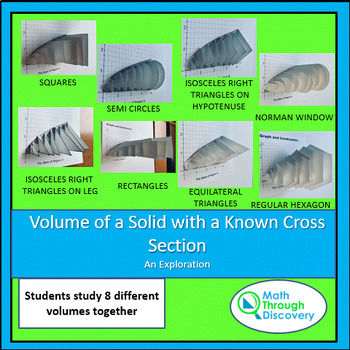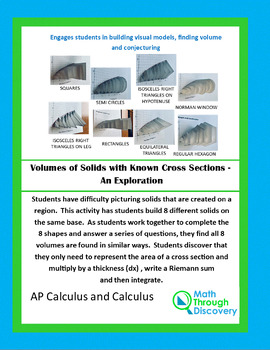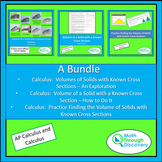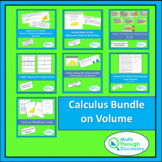Volumes of Solids with Known Cross Sections - An Exploration in Calculus
What educators are saying
Also included in
- This is a bundle of:•Volumes of Solids with Known Cross Sections – An Exploration •Volume of a Solid with a Known Cross Section – How to Do It•Practice Finding the Volume of Solids with Known Cross SectionsEach of these products can be purchased separately in my store.People who viewed this productPrice $10.60Original Price $13.25Save $2.65
- This bundle contains seven products that can be purchased separately in my store:· Activity Sheet on the Volume a Solid of Revolution· Activity Sheet on Volume of Solids with Known Cross Sections· Practice Finding the Volume of Solids with Known Cross Sections· Volume Matching Cards· Volume of SolidPrice $21.20Original Price $26.50Save $5.30
Description
One of the topics that is difficult for students to grasp is finding the volume of a solid with a known cross section. One reason is that students have difficulty with this topic is that they have difficulty drawing the solid. In this activity the students get to build eight different "solids.”
This activity focuses on finding the volume of solids that are built on a two-dimensional surface when cross section cut perpendicular to a known shape. The activity uses the region bounded by the x-axis, the function y = square root of x, and the vertical line x = 4 as the base for eight solids.
Students should work in groups on this lesson. Everyone in the group should have a different cross-section. A student can choose to work with squares, isosceles right triangles (on a leg), rectangles that are three times longer then their width, semicircle, equilateral triangles, isosceles right triangles (on their hypotenuse), Norman windows (combination of a square and semicircle), and hexagons.
Each person received a chart where they will list values for the square root of x and a graph where they will make a sketch of the square root of x. Then students cut out their nine polygons that match with f(0.25) through f(4). They bend the tabs and glue the polygons down on their graph at the appropriate x values. As the students glue the pieces on their graph the students begin to see what a solid looks like that has that cross-section. If all eight shapes are distributed, the students will make eight different shapes.
It is preferred that the eight students with different shapes form a group. They should begin working through the questions on the four-part activity sheet to develop the concept of finding the volume of a solid if you know the shape of the cross section. As students work together to complete all eight shapes and answer all the questions they find that they all use very similar techniques to find their volumes. When moving from one shape to another, the students find the only difference is the expression used for the area of the cross section. As students worked together, they wrote formulas for area, wrote Riemann sums for the volume, estimated the volume, wrote an integral for the volume, and calculated the volume.
When the students are finished making their shapes and determining their volumes, they can compare their volumes and line them up from smallest to largest by their volumes. They can also look for relationships between their volumes.
The patterns were designed as unshaded shapes so you can use colored card stock to duplicate shapes.
A complete set of answers and solutions are included.
Comments from buyers:
- Excellent activity. I laminated the shapes pages, students then cut out the pieces and used glue sticks to create the "volume.” Students answered the questions pertaining to their created shape then traded with others so they saw all shapes. Students sailed through the practice problems the next day.
- This activity provided the visuals they needed to understand the concept.
- This activity will help your students say "I like finding the volume of a solid with a known cross section. It's not so hard to do."
- After you use once, you will save it to use it again the next year. You might also want to purchase a copy for a colleague.
- Great for helping students visualize the cross-sections.
- Every time I use this file the students are amazed at how easy these problems can be to solve and how similar the problems are to each other. This activity really focuses on the concept behind the question.
- Had students work in groups and then present their shape. Worked great. Thanks
- The resource was very helpful, especially with distant learning. I explained each step and was clear and concise. I love this resource and will use again! Blessings!
Buyers who looked at this product also looked at the Activity Sheet on Volume of Solids with Known Cross Section, that is also in my store.





